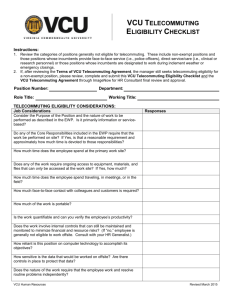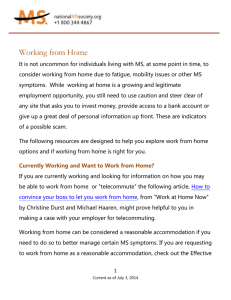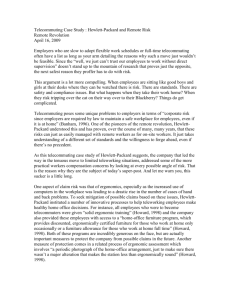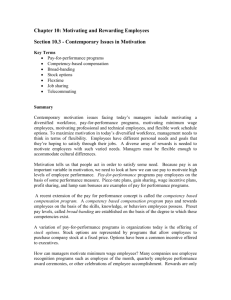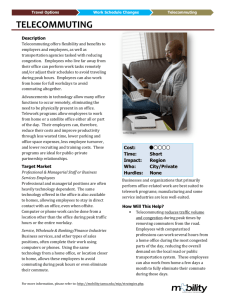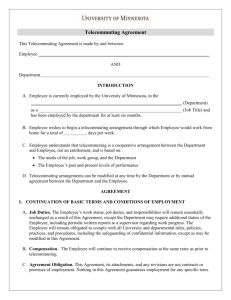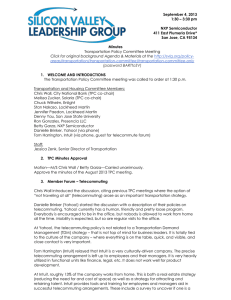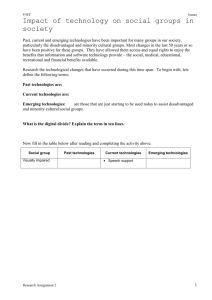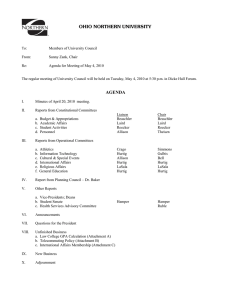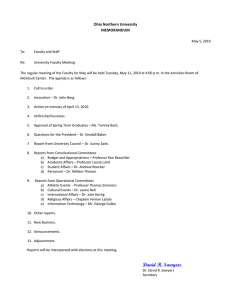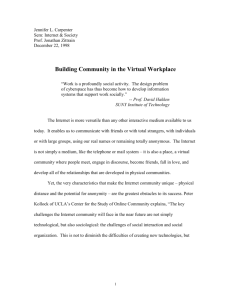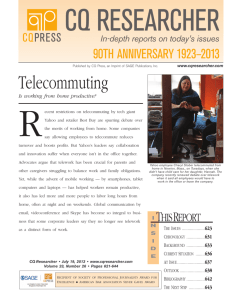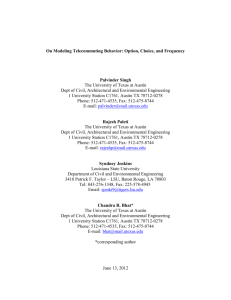Plugged-In or Burned Out? - in
advertisement
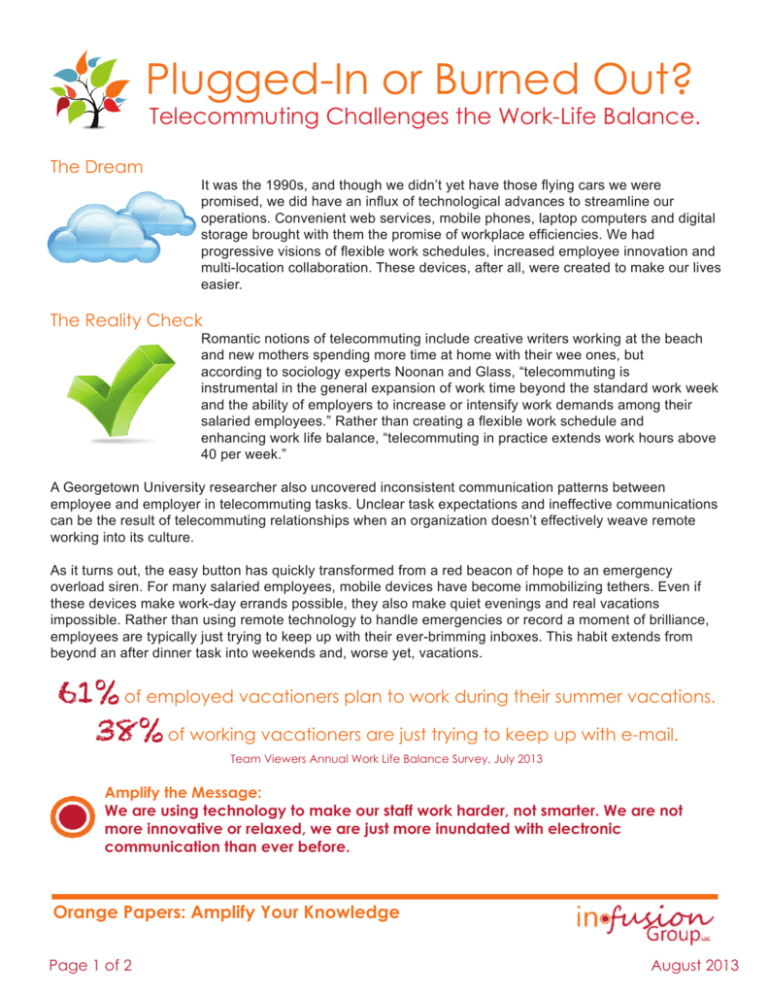
Plugged-In or Burned Out?
Telecommuting Challenges the Work-Life Balance.
The Dream
It was the 1990s, and though we didn’t yet have those flying cars we were
promised, we did have an influx of technological advances to streamline our
operations. Convenient web services, mobile phones, laptop computers and digital
storage brought with them the promise of workplace efficiencies. We had
progressive visions of flexible work schedules, increased employee innovation and
multi-location collaboration. These devices, after all, were created to make our lives
easier.
The Reality Check
Romantic notions of telecommuting include creative writers working at the beach
and new mothers spending more time at home with their wee ones, but
according to sociology experts Noonan and Glass, “telecommuting is
instrumental in the general expansion of work time beyond the standard work week
and the ability of employers to increase or intensify work demands among their
salaried employees.” Rather than creating a flexible work schedule and
enhancing work life balance, “telecommuting in practice extends work hours above
40 per week.”
A Georgetown University researcher also uncovered inconsistent communication patterns between
employee and employer in telecommuting tasks. Unclear task expectations and ineffective communications
can be the result of telecommuting relationships when an organization doesn’t effectively weave remote
working into its culture.
As it turns out, the easy button has quickly transformed from a red beacon of hope to an emergency
overload siren. For many salaried employees, mobile devices have become immobilizing tethers. Even if
these devices make work-day errands possible, they also make quiet evenings and real vacations
impossible. Rather than using remote technology to handle emergencies or record a moment of brilliance,
employees are typically just trying to keep up with their ever-brimming inboxes. This habit extends from
beyond an after dinner task into weekends and, worse yet, vacations.
61% of employed vacationers plan to work during their summer vacations.
38% of working vacationers are just trying to keep up with e-mail.
Team Viewers Annual Work Life Balance Survey, July 2013
Amplify the Message:
We are using technology to make our staff work harder, not smarter. We are not
more innovative or relaxed, we are just more inundated with electronic
communication than ever before.
Orange Papers: Amplify Your Knowledge
Page 1 of 2
August 2013
The Consequences
Employees aren’t in love with working through their vacation. The Team Viewer study also reveals that 24%
ignore or pretend not to see incoming messages and up to 8% of working vacationers even consider
leaving the job. An analysis of the study concluded that there is “nearly complete absence of a clear line
that separates being at work to being not at work.” This blurring of the work life balance may do worse than
increase your turnover, it may poison the staff who remains. According to the Mayo Clinic, work-life
imbalance (a lack of separate time for family, friends and self) and unclear job expectations are a leading
cause of job burnout. Job burnout doesn’t just make us hit the snooze button. Medically defined symptoms
of the condition include sleep disturbance, emotional eating, reliance on drugs and alcohol, cynicism, low
energy and feeling disillusioned about one’s job. This can lead to attendance issues, lack of productivity
and irritability with coworkers and clients.
Amplify the Message:
Work Life Imbalance can increase turnover and severely impact the morale and
health of remaining staff.
in-FUSE Your Solution:
Whether you are spotting signs of burn-out in your workforce or you are struggling to clarify your workload
expectations, in-FUSION Group recommends the following:
1 Review and revise your telecommuting policy for clarity. Questions you should answer
include: can an employee “clock” hours from home, or is after hours communication overtime? Are
salaried workers expected to respond to inquiries on nights and weekends? Can an employee use the
“out of office” feature while on vacation to lengthen the typical e-mail response time you expect?
2 Train your managers to look for burn-out. Recognizing the early signs of employee burnout
can be instrumental in preventing turnover and bolstering employee morale. When negativity,
tardiness and other signs are spotted in a “plugged-in” employee, it is an excellent opportunity to
review the aforementioned telecommuting policy.
3 Respect the sanctity of vacation. When an employee properly schedules approved vacation
time, respect it. Transfer critical tasks to a back-up employee and reserve phone calls and e-mails
for real emergencies. Cake in the conference room? We’re pretty sure it will be stale before they get
back.
Ellen Charlebois, Senior Partner for in-FUSION Group, has more than 25 years of human resource
management experience and currently navigates the murky waters of telecommuting herself. If you need
an expert to assist you with policy review and employee assessment, we can help.
{Contact Us: http://www.in-fusiongroup.com | info@in-fusiongroup.com | 877.224.2429}
Smart People We Quoted:
George Brown “What Vacation? Will You Be Working During Your Vacation?” July 2013
Mary Noonan and Jennifer Glass “The Hard Truth About Telecommuting” Monthly Labor Review, June 2012
Mayo Clinic “Job Burnout: How to spot it and take action” http://www.mayoclinic.com/health/burnout/WL00062
NL Reinsch “Selected Communication Variables and Telecommuting Participation” The Journal of Business Communication, July 1999
Orange Papers: Amplify Your Knowledge
Page 2 of 2
August 2013

